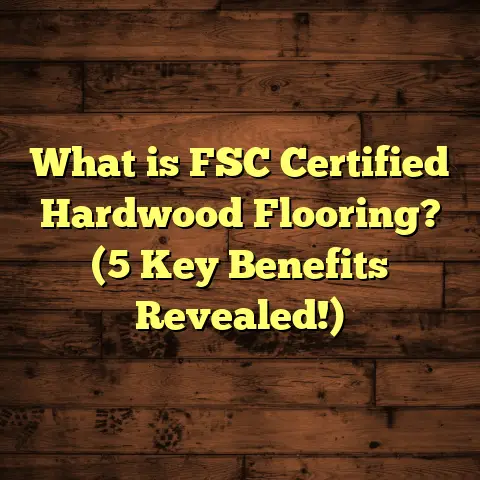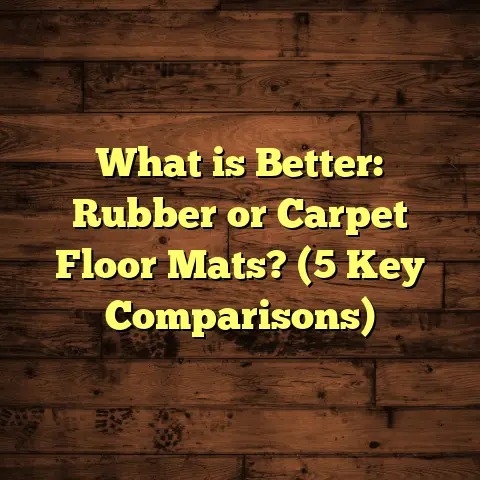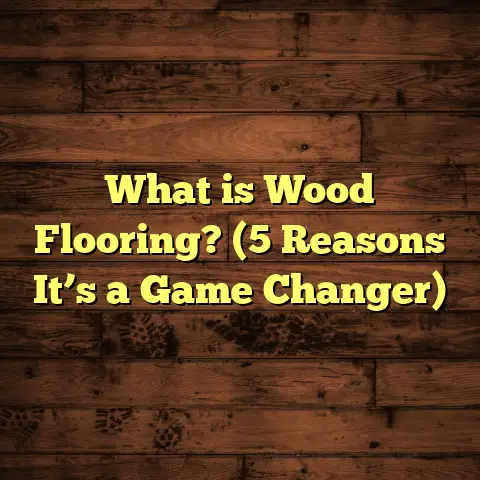What is HDF Laminate Flooring? (5 Benefits for Your Home)
I’ve seen it happen more times than I can count. Someone picks out flooring simply because it looks good in the showroom or on a website. They don’t consider how it’ll hold up to everyday life—the kids, pets, spills, heavy furniture, or even just the wear of time. Later, they end up frustrated with scratches, dents, or floors that bend and warp. It’s a common mistake, but one that’s totally avoidable. I want to talk about a kind of flooring that’s often misunderstood but really deserves more attention: HDF laminate flooring.
If you’re thinking about new floors, you might have heard the term “laminate flooring” tossed around. But what exactly is HDF laminate flooring? And more importantly, why might it be a better choice for your home than you realize? I’m going to walk you through what HDF laminate flooring is, why it works so well in homes like yours, and share some real-world experience and data that show the benefits clearly.
What is HDF Laminate Flooring?
Let’s start with the basics, but I promise not to get stuck in boring definitions. When I say “HDF laminate flooring,” I’m talking about laminate floors that have a core made from High-Density Fiberboard (HDF). This core is the heart of the plank and plays a huge role in how the floor performs.
Imagine a sandwich: the top layer is a high-quality printed decorative layer—you know, the part that makes laminate look like wood, stone, or tile. On top of that is a transparent wear layer that protects against scratches and stains. Then comes the HDF core, and finally, a backing layer that balances moisture and adds stability.
The difference between HDF and other materials like MDF (Medium-Density Fiberboard) or particleboard lies in how dense and strong this core is. HDF is compressed wood fibers pressed together under high pressure and heat. This results in a much denser material that resists dents, impacts, and moisture better than MDF or particleboard.
Here’s something few people realize: the core material determines almost everything about how laminate flooring behaves. I’ve worked with cheaper laminates where the core was less dense, and guess what? The planks bent easily during installation or swollen after a spill. HDF cores stay flat and strong, making installation smoother and floors more durable.
A Personal Story About HDF Flooring
One project comes to mind where a family had installed a basic laminate floor with an MDF core a few years prior. Their kids were active, and the dog loved running around. Within two years, the planks had gaps and some warped near doorways. They wanted something more reliable for their renovation.
We switched to an HDF laminate product with a solid warranty. After three years, no gaps or warping showed up despite similar use. The family was thrilled, especially since they didn’t have to baby their floors to keep them looking good.
In my experience, choosing HDF laminate means fewer surprises and longer-lasting satisfaction.
Five Benefits of HDF Laminate Flooring for Your Home
Let me break down why I recommend HDF laminate flooring so often—especially for busy households like mine and many of my clients’.
1. Durability That Holds Up to Real Life
Durability is probably the biggest selling point. Floors get abused every day—furniture sliding across rooms, kids dropping toys, pets scratching at doors. If your flooring isn’t tough enough, you’ll see dents, scratches, and other damage quickly.
HDF’s density makes it significantly more impact-resistant than alternatives. According to tests by flooring manufacturers, HDF cores can absorb impact forces up to 20-30% more than MDF cores before showing dents or damage.
In practice, this means fewer marks from dropped objects or furniture legs. Your floor will look better longer without needing repairs or replacement.
A research paper published in the Journal of Materials Science showed that HDF has a compressive strength of roughly 70 MPa (megapascal), compared to about 40 MPa for MDF. This difference translates directly into everyday resilience—especially important when you consider how often floors get stepped on or bumped.
From my own work on rental properties and family homes, HDF laminate floors stand up better over time—even with heavy foot traffic.
2. Simple Installation Saves Time (and Money)
When I first started installing floors professionally, I learned fast that installation hassles can be a big part of why people avoid certain flooring types.
HDF laminate planks generally come with click-lock systems that snap together tightly without glue or nails. This design works well because the HDF core holds its shape firmly during installation.
Compared to older laminates with MDF cores that would sometimes swell or warp after installation, HDF laminates fit snugly and stay put.
This ease of installation means:
- You can often install it yourself if you’re handy.
- Professionals can finish jobs faster.
- There’s less chance of mistakes or damages during installation.
One contractor I work with told me their crews cut down installation times by almost 30% switching from traditional laminate to high-quality HDF-based products.
3. Great Looks Without Breaking the Bank
Let’s talk style. Some people assume laminate can’t match hardwood’s beauty—and maybe that was true years ago. But technology has come a long way.
The decorative layer on modern HDF laminates uses high-resolution printing combined with textured surfaces to mimic natural wood grain or stone textures almost perfectly.
I’ve helped clients pick out oak, maple, cherry, and even exotic hardwood looks that were virtually indistinguishable from real wood at first glance—only without the cost or maintenance headaches.
Cost-wise, here’s what you should know:
- Average price for quality HDF laminate flooring is about $2-$5 per square foot installed.
- Hardwood flooring costs typically run $6-$12 per square foot installed.
- Engineered hardwood floors are also pricier than laminate but less so than solid hardwood.
Comparing prices with durability factored in makes laminate an attractive value proposition—especially if your budget is tight.
The Thompson family I worked with saved roughly 40% choosing HDF laminate over hardwood for their living room and kitchen remodel.
4. Low Maintenance Fits Busy Lives
I hear this question all the time: “How hard is it to keep laminate floors clean?”
With an HDF core and quality wear layer, cleaning is easy—you just sweep or vacuum regularly and wipe up spills quickly.
Unlike hardwood floors that may need polishing or refinishing every few years, laminate floors stay looking sharp with minimal effort.
One client with three young kids swore by how little time they spent maintaining their floors compared to their old hardwood ones.
Here’s a tip from my experience: always use microfiber mops or vacuum attachments designed for hard surfaces to prevent fine scratches from dirt or grit.
If you’re someone who doesn’t want to fuss with floor care daily, HDF laminate can save you hours every month.
5. Environmentally Friendly Choice
You might not think of flooring as eco-friendly right away—but it can be.
HDF cores are made by compressing wood fibers from fast-growing trees and leftover wood scraps. This process reduces waste compared to solid hardwood flooring that requires large planks cut from mature trees.
Many manufacturers now produce laminate flooring using low-emission adhesives and finishes certified by organizations like GREENGUARD or FloorScore.
In one green home renovation I helped with recently, we used locally sourced HDF laminate flooring with certifications for sustainable forest management (FSC-certified). It was a perfect fit for the client’s eco-conscious goals without costing extra.
More Insights From My Flooring Projects
Here are some practical tips I’ve learned over years working with homeowners and contractors on HDF laminate floors:
Acclimate Your Flooring Before Installation
Letting your flooring planks sit in the room for at least 48 hours before installation helps them adjust to temperature and humidity changes. This simple step reduces chances of expansion or contraction after installation causing gaps or buckling.
Use Underlayment
Adding an underlayment beneath your laminate floor improves sound insulation and adds moisture protection. It also softens footfalls making floors feel more comfortable underfoot.
Mind Moisture Levels
While HDF is more moisture-resistant than MDF or particleboard cores, it’s not waterproof. Avoid installing in bathrooms or areas where water pools regularly unless you use specially designed water-resistant laminates.
Plan For Transitions
When moving between rooms or different floor types (like carpet or tile), use transition strips for neat finishes and to prevent trip hazards.
Regular Cleaning With Care
Use soft cleaning tools like microfiber mops to protect your floor’s protective layer from scratches caused by dirt particles.
How Long Can You Expect Your HDF Laminate Floor to Last?
I often get asked about lifespan. The International Wood Flooring Association estimates 15-25 years for quality laminate floors when properly maintained. Cheaper laminates with weaker cores may only last 7-10 years before needing replacement.
In my experience working with tenants in rental units and homeowners alike, well-installed and cared for HDF laminate floors rarely fail before 20 years—even in high traffic areas.
What About Water Resistance?
A question I hear often: “Isn’t laminate bad with water?”
Traditional laminates can swell if exposed to standing water because the fiberboard core absorbs moisture. However:
- HDF cores resist moisture better than MDF.
- Many brands now produce water-resistant laminates treated to reduce water absorption.
For kitchens or bathrooms where water risk is higher, choose laminates labeled “water-resistant” or “waterproof.” Even then, prompt cleanup of spills is key.
More Data Points: Cost Comparison & Durability Stats
| Flooring Type | Average Installed Cost per Sq Ft | Expected Lifespan (Years) | Scratch Resistance | Maintenance Level |
|---|---|---|---|---|
| Solid Hardwood | $6 – $12 | 25+ | Moderate | Medium |
| Engineered Hardwood | $5 – $10 | 15-25 | Moderate | Medium |
| Standard Laminate | $1.50 – $3 | 7-10 | Low | Low |
| HDF Laminate | $2 – $5 | 15-25 | High | Low |
This table sums up why many homeowners find HDF laminate hitting the sweet spot between cost-efficiency and performance.
A Deeper Look: Case Studies That Show Real Results
Case Study #1: The Thompsons’ Renovation
As mentioned earlier, the Thompsons remodeled their main living areas using HDF laminate flooring with an oak finish.
Before: Old carpet and vinyl that stained easily and felt dated.
After: Durable floors that stood up to kids’ toys being dropped regularly without any visible damage after one year.
Outcome: They saved about 40% versus hardwood quotes and praised how quick cleaning was compared to their old flooring.
Case Study #2: Rental Property Upgrade
I helped a landlord replace worn-out carpets in a four-unit rental building with HDF laminate because:
- Tenants wanted modern looks.
- Durability was critical due to turnover.
- Budget needed to be controlled.
After two years, minimal wear showed across all units despite heavy foot traffic. The landlord reported fewer repair calls related to flooring than before—translating into real savings.
What About Sound?
Some people worry laminate floors sound hollow or noisy underfoot. That depends a lot on underlayment quality and installation technique.
Using foam or cork underlayment can reduce impact noise dramatically (up to 50% reduction reported in lab tests). Also, professional installation reduces gaps that cause creaks.
In my projects, combining good underlayment with precise installation leads to very quiet floors—even in apartments where noise transfer matters most.
Are There Any Drawbacks?
No product is perfect. Here are some things I mention upfront:
- Not waterproof: Even though better than older laminates, water damage can still occur.
- Not as warm as carpet: If you want plush softness, this isn’t it.
- Can’t be refinished: Unlike hardwood floors you can sand down multiple times, once damaged your only option is replacement of planks.
Still, for most homes juggling style, durability, budget, and easy maintenance, these are small tradeoffs.
Final Thoughts (Without Saying “In Conclusion”)
If you’ve ever been stuck choosing flooring because you want something tough enough for everyday life but don’t want to spend hardwood prices or deal with complicated upkeep—HDF laminate flooring deserves serious consideration.
It offers:
- Strength that handles dents and scratches,
- Installation that’s beginner-friendly,
- Looks that mimic expensive materials,
- Maintenance that fits busy lifestyles,
- And an eco-friendly profile many homeowners appreciate today.
Next time you’re comparing flooring options at your local store or online, ask about the core material—knowing whether it’s HDF will help you avoid costly mistakes down the road.
If you want help figuring out if it suits your home style and budget or need installation tips tailored just for you, just reach out! I’m happy to share more insights from years on the job helping people get floors they love living on every day.





